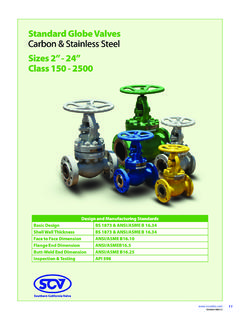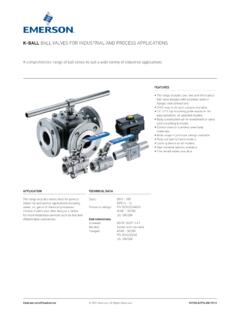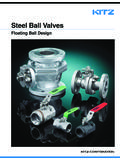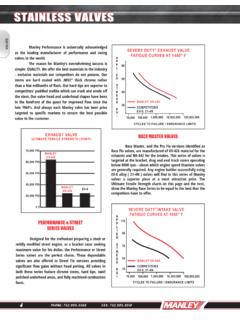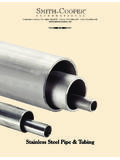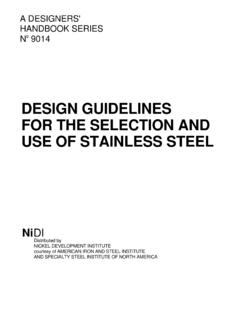Transcription of High Alloy Stainless Steels for Fisher Valves
1 , Super Duplex, and Super AusteniticStainless Steels for Fisher ValvesHigh Alloy Stainless SteelsFor many years, the 300 series Stainless Steels (SST)have been the workhorse alloys for corrosiveapplications. For severe applications, the nickel basealloys were the next step up in corrosion cost differential, however, was great (four to tentimes, or more). In recent years, duplex andsuperaustenitic SSTs have started to fill this void ascost effective Alloy SSTs are similar to the 300 series SSTswhereas they are iron base with significant additions ofchromium, nickel, and molybdenum.
2 To produce aduplex SST, the Alloy chemistry is adjusted byincreasing the chromium and molybdenum andreducing the amount of nickel, see the followingfigure. These changes result in both ferrite andaustenite phases present in approximately equalamounts. By contrast, the 300 series SSTs are generallyfully austenitic. Superaustenitic SST's have the samestructure as the common 300 series alloys, but havehigher levels of elements such as chromium, nickel,molybdenum, copper and Alloy SST's are often used where chlorides or sourgas are encountered. Industries include pulp andpaper, chemical, oil and gas, power, desalination, of high Alloy Stainless Steels are.
3 N Superior stress corrosion cracking resistance andcorrosion resistance in chloride environmentscompared to the standard austenitic materials suchas Yield strengths significantly higher or even doublethat of annealed 300 series Duplex SST's have inherently better resistance tostress corrosion cracking than 300 seriessingle phase alloys, because at least one of thephases is often resistant to cracking in a of a Typical Cast Duplex Stainless SteelW8154 High Alloy SST's are commonly ranked by an empiricalformula to calculate their pitting resistanceequivalency number [PREN = %Cr + +30%N].
4 Higher PREN's correlate to improved resistanceto pitting corrosion. See table 1. The standard duplexSST grades have a PREN of 30 40. Superduplex SSTgrades have a PREN of greater than measure of corrosion resistance is the criticalpitting temperature (CPT). Tests are conducted to therequirements of ASTM G48 practice A; 6% ferricchloride. A series of tests are run at increasingtemperatures. The CPT is the minimum temperatureat which pitting corrosion occurs. See table third measure of corrosion resistance is thethreshold temperature for chloride stress corrosioncracking (SCC) in 4% sodium chloride.
5 Again a series oftests are run at increasing temperatures until SCCoccurs. See table Alloy Stainless SteelsD102757X012 Product Bulletin59:025 September 2017 High Alloy Stainless SteelsD102757X012 Product Bulletin59:025 September 2017 2 Because the nickel content of a duplex SST is lowerthan S31600, one would expect the prices to beslightly lower. However, the opposite is true for tworeasons:n Duplex SSTs are produced in much lower volumesthan the 300 series The higher strength of the duplex and specialprocessing requirements increase 1. Measures of Resistance to Pitting and Stress Corrosion Cracking.
6 These are typical values, not forspecification (4)CPT(1)SCC(1)_C_F_C_FS31600CF8M262815( 3)60(3)55(3)130(3)S31803 DuplexCD3MN Duplex353530(3)85(3)150(3)300(3)S32760 Super DuplexCD3 MWCuN Super Duplex444470(3)160(3)250+(3)480+(3)S3125 4 Super AusteniticCK3 MCuN Super Austenitic434570(3)160(3)250+(2,3)480+(2 ,3)1. NACE Corrosion 94 Conference Paper by R. Francis, The Performance of Duplex Stainless Steels in Chemical Environments, NACE Corrosion Estimated by Emerson Automation Due to elemental segregation and other factors, the cast grades may have lower threshold values than the wrought These are typical mid range values; not for specification 2.
7 High Alloy SST GradesGradeTypical CompositionCast EquivalentForged EquivalentPlate EquivalentS31803 DuplexCD3MN Duplex (commonly called 2205)22% chromium, 5% nickel, 3% molybdenumASME SA995 GradeCD3MN or 4 AASME SA182 Grade F51 ASME SA240S31803S32760 Super DuplexCD3 MWCuN Super Duplex (UNSJ93380)25% chromium, 7% nickel, , and traces oftungsten and copperASME SA351 GradeCD3 MWCuN or 6 AASME SA182 Grade 55 ASME SA240S32760S31254 Super AusteniticCK3 MCuN Super Austenitic (commonly called 254 SMO20% chromium, 18% nickel, 6%molybdenum, 1% copperASME SA351 GradeCK3 MCuNASME SA182 Grade F44 ASME SA240S31254 Table 3.)
8 Compliance of High Alloy SST Grades with NACE SpecificationsGradeNACE MR0175 2002 NACE MR0175/ISO 15156 NACE MR0103S31803 DuplexCD3MN DuplexWrought form only acceptable to 28 HRC hardnessWrought and cast acceptable withsome environmental restrictionsOffered only as block forgedbodies. Welding is prohibited(1)S32760 Super DuplexCD3 MWCuN Super DuplexBoth wrought and cast acceptablewith some restrictionsWrought and cast acceptable withsome environmental restrictionsOffered only as block forgedbodies. Welding is prohibited(1)S31254 Super AusteniticCK3 MCuN Super AusteniticWrought and cast acceptable withsome restrictionsWrought acceptable withenvironmental restrictions.
9 Castacceptable to 100 HRB withoutenvironmental and cast acceptablewithout restrictions to 35 HRChardness1. The duplex SST welding restrictions in NACE MR0103 are very restrictive and cost prohibitive. Forged Valves are offered with no welding permitted. Cast Valves are not offered by EmersonAutomation Solutions at this Alloy Stainless SteelsD102757X012 Product Bulletin59:025 September 2017 3 Preferred Grades for FisherValvesA summary of the varieties of high Alloy SST's is shownin table 2. In an effort to increase volumes and controlcost, we have standardized our offerings.
10 To providethe optimum properties and the best value to ourcustomers, we have standardized on:n S31803 and CD3MN Duplex (best cost)n S32760 and CD3 MWCuN Super Duplex ( middle cost)n S31254 and CK3 MCuN Super Austenitic (higher cost)Our preferred grades are superior materials. Byconcentrating on specific grades, we can keep yourcosts lower and provide you materials in a moreefficient , CD3MN DuplexS31803 contains approximately 22% chromium, 5% nickel, and 3% molybdenum. S31803 is commonlycalled 2205 and is the most widely used duplexstainless steel.










